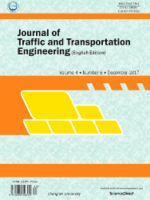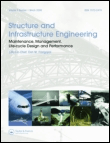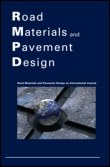
Journal of Transportation Engineering Part B-Pavements
Scope & Guideline
Pioneering Research for Durable Pavements
Introduction
Aims and Scopes
- Pavement Materials and Mixtures:
Research on the properties, performance, and optimization of various pavement materials, including asphalt, concrete, and innovative mixtures, such as those incorporating recycled materials. - Pavement Design and Analysis:
Development of mechanistic-empirical design frameworks and methodologies for evaluating pavement structures under varying load conditions, environmental influences, and material characteristics. - Pavement Performance and Maintenance:
Assessment of pavement performance through field and laboratory studies, including predictive modeling, deterioration analysis, and maintenance strategies for extending pavement life. - Innovative Technologies and Methods:
Utilization of advanced technologies, such as machine learning, deep learning, and automated systems for pavement monitoring, distress detection, and condition assessment. - Sustainability and Environmental Impact:
Exploration of sustainable practices in pavement engineering, including the use of recycled materials, low-impact construction techniques, and life-cycle assessments. - Safety and User Experience:
Evaluation of pavement characteristics related to safety, including skid resistance, ride quality, and the impact of pavement conditions on vehicle performance and user comfort.
Trending and Emerging
- Machine Learning and Data Analytics in Pavement Engineering:
The use of machine learning and data analytics has surged, with numerous studies focusing on predictive modeling for pavement performance, distress detection, and optimization of maintenance strategies. - Sustainable Pavement Solutions:
Emerging research is increasingly centered on sustainability, exploring the use of recycled materials, eco-friendly binders, and innovative practices that minimize environmental impact. - Advanced Monitoring Technologies:
There is a growing trend in the application of advanced monitoring technologies, including UAVs, remote sensing, and automated systems for real-time pavement condition assessment. - Performance-Based Design Approaches:
Research is increasingly focusing on performance-based design methodologies that incorporate real-world data and predictive analytics to improve the reliability of pavement systems. - Impact of Climate Change on Pavement Performance:
An emerging theme involves understanding how climate change affects pavement performance, leading to studies on resilience and adaptation strategies for infrastructure.
Declining or Waning
- Traditional Pavement Inspection Techniques:
There has been a noticeable decrease in research focused on conventional methods of pavement inspection, as advanced technologies like UAVs and machine learning are taking precedence for their efficiency and accuracy. - Low-Temperature Performance of Asphalt:
Research related to low-temperature performance of asphalt mixtures appears to be waning, possibly due to a shift towards more pressing issues such as sustainability and the performance of recycled materials. - Standardized Laboratory Testing Methods:
The emphasis on traditional standardized laboratory methods is decreasing as researchers increasingly explore innovative and adaptive testing techniques that provide more relevant and real-world data. - Impact Studies of Single Pavement Treatments:
There is a declining trend in studies focusing solely on the impact of individual pavement treatments, as more comprehensive life-cycle assessment approaches are favored. - Basic Theoretical Models of Pavement Behavior:
Research that relies heavily on basic theoretical models without considering contemporary data-driven approaches is becoming less prevalent, reflecting a shift towards more complex and multifactorial analyses.
Similar Journals

Transportation Infrastructure Geotechnology
Transforming Transportation through Geotechnical Excellence.Transportation Infrastructure Geotechnology, an esteemed journal published by SpringerNature, serves as a vital platform in the fields of Civil and Structural Engineering, Environmental Engineering, Geotechnical Engineering, and Transportation. Established in 2014 and spanning a decade of significant scientific discourse, this journal has gained recognition for its robust contribution to the understanding of the interplay between geotechnical processes and transportation infrastructure. With an impactful Q2 ranking in multiple categories—including Civil and Structural Engineering and Environmental Engineering—it emphasizes innovative research and practical applications globally. Researchers and professionals can explore critical topics that influence infrastructure sustainability, safety, and efficiency. Although it operates under a subscription model, its affiliation with SpringerNature ensures rigorous peer-review and high-quality publications, making it an indispensable resource for academics and industry experts alike.

Engineering Reports
Elevating the standards of engineering research and collaboration.Engineering Reports is a premier open-access journal published by Wiley, dedicated to advancing the fields of Engineering and Computer Science. Since its inception in 2019, this journal has rapidly gained recognition, achieving a commendable Q2 ranking in both the engineering and computer science categories in 2023, evidencing its impactful contributions to the scientific community. With an impressive Scopus rank of #70/307 in General Engineering and #63/232 in General Computer Science, the journal is well-positioned to disseminate cutting-edge research and foster innovation. Researchers, professionals, and students will find value in its comprehensive scope, which includes emerging technologies and interdisciplinary studies, making it an essential resource for anyone involved in these dynamic fields. Accessible online, Engineering Reports aims to bridge the gap between complex engineering theories and practical applications, enhancing collaboration and knowledge sharing globally.

Facilities
Elevating research in architecture and human factors for over four decades.Facilities is an esteemed international journal, published by Emerald Group Publishing Ltd, dedicated to advancing the scholarly discourse in the multifaceted areas of architecture, building construction, and human factors and ergonomics. Since its inception in 1983, the journal has celebrated over four decades of research contributions, maintaining a robust E-ISSN of 1758-7131 while its print identifier is ISSN 0263-2772. With its distinguished status, it ranks in the Q1 quartile in Architecture and is positioned in the Q2 quartile for both Building and Construction and Human Factors and Ergonomics in 2023. The journal’s Scopus rankings highlight its relevance, achieving a remarkable 88th percentile in Architecture and 68th percentile in Building and Construction. Although not an Open Access publication, Facilities provides vital insights and research findings that cater to academics, practitioners, and students alike, fostering innovation and informed practices across these dynamic fields. Its commitment to high-quality scholarship makes it an indispensable resource for anyone engaged in improving the interaction between people and the built environment.

International Journal of Sustainable Construction Engineering and Technology
Exploring cutting-edge solutions for eco-friendly construction.International Journal of Sustainable Construction Engineering and Technology is a pivotal publication in the evolving fields of building and construction, civil and structural engineering, and environmental engineering. Published by University Tun Hussein Onn Malaysia, this journal serves as a platform for the dissemination of innovative research and developments dedicated to sustainable practices in construction and engineering. With an ISSN of 2180-3242, this journal has been contributing to the academic community since its inception, with coverage from 2018 through 2024. While currently categorized in quartiles Q4 for both building and construction and civil engineering, and holding similar ranks in environmental engineering, the journal continues to strive for academic excellence and broader outreach. The journal, although currently not an open access platform, remains an important resource for professionals, researchers, and students aiming to explore sustainable methodologies and technologies in construction. We invite you to engage with cutting-edge studies that address environmental impacts in engineering and contribute to a sustainable future in infrastructure development.

Journal of Machinery Manufacture and Reliability
Driving excellence in machinery manufacture and safety standards.The Journal of Machinery Manufacture and Reliability, published by PLEIADES PUBLISHING INC, serves as a pivotal platform for advancing knowledge in the fields of Industrial and Manufacturing Engineering, Mechanical Engineering, and Safety, Risk, Reliability, and Quality. Having adopted an Open Access model since 2015, this journal facilitates global dissemination of research findings and innovations, ensuring that critical developments in machinery manufacture resonate across the academic and professional spectrum. With its ISSN 1052-6188 and E-ISSN 1934-9394, it has established itself within established quartiles, notably Q3 in key engineering categories according to the 2023 metrics. Its Scopus rankings underscore its emerging impact, though it remains an area for growth, making it an excellent venue for early-career researchers aiming to contribute to a growing body of literature. The journal's commitment to high-quality, accessible research positions it as a must-read for academics and practitioners alike, fostering innovation and collaboration in the machinery manufacturing sector.

Journal of Traffic and Transportation Engineering-English Edition
Exploring New Horizons in Traffic Management and Transportation Studies.Journal of Traffic and Transportation Engineering-English Edition, published by KEAI PUBLISHING LTD, is a leading open-access journal that has been disseminating valuable research in the realms of civil and structural engineering, as well as transportation studies since 2014. With a robust impact factor reflected by its prestigious Q1 rankings in both Civil and Structural Engineering and Transportation, this journal stands at the forefront of innovation and scholarship, featuring contributions from experts across the globe. The journal is particularly noted for its practical and theoretical advancements in traffic and transportation engineering, making it indispensable for researchers, industry professionals, and students aiming to deepen their understanding of these critical fields. Dedicated to providing a platform for high-quality interdisciplinary research, the Journal of Traffic and Transportation Engineering embraces the principles of open access, ensuring that all published articles are freely available to foster knowledge sharing and collaboration within the community. With its headquarters located in Beijing, China, the journal continues to push boundaries and set new standards in the field of traffic and transportation research.

Russian Journal of Building Construction and Architecture
Connecting Theory and Practice in Sustainable DevelopmentRussian Journal of Building Construction and Architecture (ISSN: 2542-0526; E-ISSN: 2542-0526), published by the esteemed Voronezh State Technical University, serves as a vital platform for disseminating innovative research and practical applications in the fields of building construction and architecture. This journal, situated in Voronezh, Russia, aims to explore both the theoretical and empirical aspects of contemporary architecture and construction practices, fostering a robust dialogue among researchers, professionals, and academics. With an emphasis on open access to knowledge, the journal significantly contributes to global discourse by ensuring that findings are accessible to a wide audience. Underlining the importance of sustainable development and cutting-edge technologies in construction, the journal strives to publish high-quality research that addresses the challenges faced in today’s building environment, making it an invaluable resource for those committed to advancing the industry.

Structure and Infrastructure Engineering
Pioneering Research for Sustainable Engineering SolutionsStructure and Infrastructure Engineering, published by TAYLOR & FRANCIS LTD, is a premier academic journal that serves as a vital resource in the fields of engineering and construction. Featuring an ISSN of 1573-2479 and an E-ISSN of 1744-8980, this journal has established its reputation as a leader in disseminating high-quality research. Since its inception, it has successfully transitioned through converged years from 2007 to 2024, earning a prestigious position within the Q1 quartile across multiple engineering disciplines, including Building and Construction, Civil and Structural Engineering, and Ocean Engineering, among others. Its impact is underscored by impressive Scopus rankings, particularly its 5th rank in Ocean Engineering within the top 95th percentile. The journal’s commitment to advancing knowledge in safety, risk, reliability, and quality makes it an indispensable platform for researchers, professionals, and students aiming to stay at the forefront of engineering innovations. Access to its comprehensive articles allows for a deeper understanding of contemporary challenges and solutions in infrastructure development.

Road Materials and Pavement Design
Innovating the Future of Roadway InfrastructureRoad Materials and Pavement Design, published by Taylor & Francis Ltd, is a premier journal in the field of civil and structural engineering, with a focus on the innovative materials and design methodologies that shape modern roadway infrastructure. Boasting an impressive impact factor and ranking in the Q1 category for civil engineering as of 2023, this journal stands at the forefront of academic research, ranking 49th out of 379 in its category with a commendable 87th percentile in Scopus. Since its inception in 2000, it has provided a vital platform for disseminating groundbreaking research, fostering collaboration, and advancing knowledge in road construction and pavement technology. Ideal for researchers, professionals, and students alike, this journal offers a comprehensive range of articles, reviews, and case studies that address contemporary challenges and developments in the field. Although it does not offer open access, the journal's commitment to quality and rigor ensures that it remains a crucial resource for anyone seeking to deepen their understanding of road materials and pavement design.

INTERNATIONAL JOURNAL OF VEHICLE DESIGN
Exploring the Future of Automotive EngineeringThe INTERNATIONAL JOURNAL OF VEHICLE DESIGN is a distinguished publication that has been at the forefront of automotive engineering and mechanical design since its inception in 1979. Published by INDERSCIENCE ENTERPRISES LTD in the United Kingdom, this journal aims to foster innovative research and technical knowledge in the field of vehicle design, encompassing various aspects from conceptualization to manufacturing and performance analysis. With an ISSN of 0143-3369 and an E-ISSN of 1741-5314, the journal extends its accessibility to a global audience, although it currently does not operate under an open access model. Recognized for its scholarly contributions, it holds a Q3 ranking in Automotive Engineering and a Q4 ranking in Mechanical Engineering as of 2023, reflecting its position among peers with an increasing impact in the discipline. Researchers, professionals, and students will find valuable insights and cutting-edge research in the articles published, contributing to a deeper understanding of advancing vehicle technologies and methodologies. For inquiries, the journal is based at the World Trade Center Building, 29 Route de Pré-Bois, Case Postale 856, CH-1215 Geneva, Switzerland, where one can also follow its developments and contribution to the growing body of knowledge in vehicle design.